
Yankees, Blue Pigs, and a Castle:
The Northern Neck And The Civil War
By William Hathaway Chapman, Jr.
Updated July 7, 2007
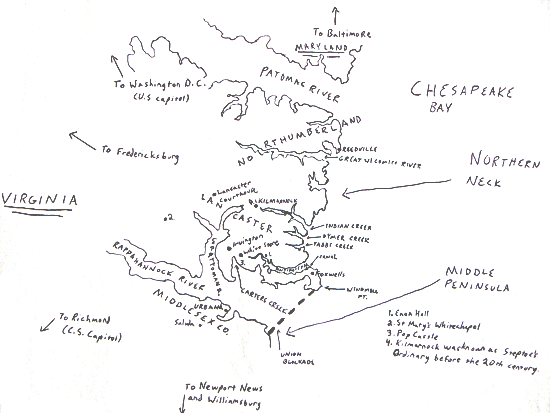
A map of the southern tip of the Northern Neck and the surrounding area (Click to enlarge.)
In the past, we have mentioned different interesting tidbits about what life was like at Enon Hall during the Civil War. I decided to take it a step further and compile most of what we know about the Northern Neck in the 1860's into a post on the website. Why? The Civil War was an immensely important event in US history. Everyone in the country was affected by it and the Hathaway family was no exception. Here, I hope to let their story and the stories of other families near them be told.
By the 1850's, the Northern Neck had grown to be a prosperous area of farms and fisheries. Local oysters had generated global popularity for their taste and size. The local economy reflected it. The mid nineteenth century was a good time to be a waterman on the Chesapeake Bay. Many new techniques of fishing and oystering were being implemented by that time and the results were lucrative. There was even more money to be had in farming. The census of 1850 shows that farming was the most popular profession in Lancaster County. The Northern Neck was potato and livestock country. King cotton was not a popular crop in the area, even though it had so much success in other parts of the south. It was potatoes that was probaby the main crop raised at Enon Hall.
Henry Straughan Hathaway (my gggg grandfather) was the oldest of the Hathaways living by 1860. In 1860, he had just been married the previous year to his second wife, Felicia Toler Dunaway, a local school teacher. Henry had one son at that point, Lucellus (my ggg grandfather). Lucellus was thirteen years old in 1860 and probably helped with work on the farm. The Hathaways also had three daughters, Octavia, Columbia, and Lillie. Henry was a prominent figure in Lancaster County. He was a justice of the peace at the courthouse as well as a landowner. Enon Hall encompassed most of the North side of Antipoison creek by 1860. The house consisted of the Dutch colonial portion and the 1850's addition. There were ten slaves living on the property. One of them was Alan, Henry's man servant.
The war broke out in 1861. That same year, Virginia seceeded from the Union and became part of the Confederate States of America. Chances are, the Hathaways favored the decision to leave the Union. We can assume this because the Northern Neck's votes in the presidential election of 1860 had almost all been for Breckinridge, a pro-slavery southern Democrat. We can also assume fairly well that Henry cast his ballot for the candidate who was going to let the south have its way. Wherever Henry's sympathies lay, he became the Captain of the Lancaster County home guard in 1861. The home guard was formed to protect the people of the county from any kind of Northern attack. Lucellus was too young to join the army, being only fourteen, and would not join until much later in the war.
There were two other millitary units from Lancaster besides the home guards. The 40th Virginia Infantry "Lancaster Grays" was formed in the
Spring of 1861. Also, the "Lancaster Cavalry" was formed in April
of 1861. The flag of the Lancaster Grays is currently in the collection at the Museum
of the Confederacy in Richmond.
The Grays and the cavalry traveled all over Virginia and fought in several
pivotal battles of the war. In a letter written home by one man in the Grays, Jesse Shelton, he mentioned that he had received a letter from Mr. Hathaway. Chances are, the Hathaways were good friends with many of the men who went off to fight.
Back on the homefront, 1861 probably proved to be
a nerve-racking year for the residents of Lancaster County. The Anaconda
Plan, a devastating blockade set up by Union General Winfield Scott to stop the flow
of supplies into the south, took effect in that year. Hundreds of Union
gunboats showed up in the Chesapeake Bay, ready and willing to open fire on
any vessel that ventured too far from shore. Stories quickly spread of the
cruelty of the men on the gunboats and the raids that they conducted on
plantations for food. The home guards readied themselves to respond to any
attack on the innocent people of their county.
The home guard got their opportunity to fight on June 24, 1861. The Star of
New York, a Federal gunboat, came up the Rappahannock River to Pop Castle,
the home of James Gresham. Three barges filled with troops were sent ashore
to conduct a raid on the large house. Mr. Gresham was confronted by several
of the soldiers. One asked Gresham if he would sell them one of his chickens
but he replied "Not a d----d one for that party!" Gresham
proceeded to tell the Yankees that there were troops not far away and he did
not want his property to be the site of a battle. At the same time, the
home guard was marching toward the house, presumably under command of Captain Henry Hathaway. The Yankees fled to their barges when the home guard opened fire on them. In their
haste, they left one of the barges behind. The gunboat began to shell the
house and one shell passed through the wall and into the bedroom where
Gresham's ill mother was sleeping. She was not hurt. The Union troops had two
casualties and left a lot of equipment on the shore when they fled. The
home guard sucessfully repulsed the attack and sustained no casualties.
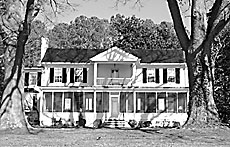
Pop Castle today.
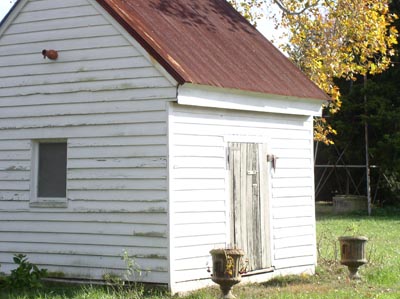
Any home with a smokehouse or a good store of food was sought out by Yankee raiders.
1861 proved to be a busy year for the home guard. They had set up two camps in
Lancaster County. One was at the Methodist Church and the other was at an
18th century church called St. Mary's Whitechapel. White Stone Methodist
church is only several miles from Enon Hall, so it is likely that Henry
stayed there. The Rappahannock River was blockaded, much to the outrage of
the citizens of Lancaster County. Also, there is a canal at Fleets Island (near Windmill Point at the mouth of Antipoison Creek) that was dug during the Civil War as an avenue for Confederate blockade runners. There was a signal station not far from the canal that was used to notify the blockade runners of the positions of Union gunboats. It seemed like the tensions between the men on the gunboats and the local home guards were ready to snap at any moment. All that anyone could do
was wait.

The canal at Fleets Island
The Lancaster Grays fought in the battle of Gaines Mill in 1862. One of the
men, who probably knew the Hathaways, was mortally wounded in the fighting
there. His name was Abner Revere. Revere had been the owner of a farm called
Osceolla. Other wounded and killed men in 1862 included Thomas Denny and
Richard Lathan. It was always sad news on the homefront to learn of the death
of a loved one. In Lancaster County, all of the men were not only loved ones
but members of a close-knit community.
Several reports say that Lancaster County had become "entirely
destitute" by 1862. What little crops and livestock that were left were either stolen by Union raiders or eaten by the starving citizens.
It is likely that Enon Hall was picked clean by the time fall of 1862 came
around. The people of Lancaster County accused the northern government of
unleashing cavalry on them who treated the people with the utmost cruelty and
disrespect. There is one account (previously mentioned in the Journal) that
says that Yankee raiders stole most of the horses at Enon Hall as well as
Henry's body servant, Alan, and a "blue pig". The blue pig, we discovered, was probably a mix between a black and a white pig. Any livestock would have been treasured by the Union cavalry, for they received few rations when they were outside of the major theatres of the war. One account of the raid says that a very well-mannered Union cavalry officer came to the door and apologized that he and his men were going to have to take all of the food in the house. They proceeded to take everything that could be eaten from the kitchen and smokehouse.
In Northumberland county (North of Lancaster), there were a number of skirmishes between the Northumberland home guards and Federal troops. According to Bertrand Haynie, a former member of the guard, "We had several skirmishes with the raiders, one in the vicinity of Lotsburg where we captured a horse and perhaps killed the rider." Haynie goes on to tell of another skirmish with a Union gunboat that was going up the Great Wicomico River. The boat tried to shell the banks but either overshot or shot too high. Nobody was killed in that particular fight. Other firsthand accounts tell of several shellings on the Great Wicomico. Reverend C.T. Thrift of Northumberland County wrote, "Marauding parties landed and did much pillaging. Poultry and pigs were taken."
There are a few stories about the Eubank family who lived on both sides of the Rappahannock River. In Middlesex county, Kilpatrick's Mounted Devils got the idea to raid one of the Eubanks' plantations, Prospect. The Eubanks had one horse that they were especially fond of and knew that Kilpatrick's men would take it if it was left in the barn. The slaves led the horse into the house and took it upstairs to one of the bedchambers. Sure enough, the Mounted Devils came to Prospect and neglected to check upstairs.
The war also made people desperate. At another one of the Eubank plantations, Nesting, the plantation owner, Joseph Eubank, resorted to giving rifles to four of his trusted slaves in order to protect his land. This was risky, because if the slaves decided to revolt, they would have more of a chance. The slaves were stationed at the gate to the house and told to fire at any Union raiders. Nesting was probably never raided, but smoke and gunboats from the other side of the Rappahannock (the Northern Neck) could easily be seen.
Now would be a good time for me to point out Enon Hall's geographical
location in relation to a few major Civil War battles. Fredericksburg is up the Rappahannock a good ways towards the base of the Neck. That is where the battles of Fredericksburg, Spotsylvania Courthouse, and the Wilderness happened in the same general area. News of those battles was definitely very frightening to the people of the Northern Neck when they happened in 1863. A year earlier, the Peninsula Campaign occured just two peninsulas down from the Northern Neck. There were literally battles going on all around the Neck but the land here never saw any major millitary action. Just across the Rappahannock River, in Urbanna, many raids and skirmishes played out dangerously close to the place the
Hathaways called home.
At the beginning of the war, Union general McClellan had a plan that involved Urbanna as an invasion point. From there, he planned to march up the Middle Peninsula and then go to Richmond. To McClellan's disappointment, the plan was rejected by the administration. McClellan ranted in his memoirs about the "inability of the administration to comprehend the merits of the scheme."
According to Lancaster County, Virginia: Where the River Meets the Bay by
Carolyn Jett, "In May of 1863, a Federal army officer reported that
operation on the Northern Neck had resulted in the destruction of 50 boats
and goods in transit worth $30,000, and in the taking of 800 slaves, 40 or 50
prisoners (including two officers), plus many mules and horses." This
kind of raiding proved to be devastating to the Neck. Technically, the Neck
was under Union control for almost the entire war, even though most of the
residents refused to admit so.
There is one account of a raid of the property of a Mr. Leland of Windmill
Point. Apparently, the Yankees arrived in gunboats and Leland scared them off
by firing his musket into the air and giving a few rebel yells.
Just across the Rappahannock from Enon Hall, in Matthews county, several forts had been constructed earlier in the war in order to protect the peninsula from Yankee attacks. One of these was an earthen fortification known as Fort Nonsense. It had such a name because in 1863, when it was captured by the Union without a struggle, a local farmer remarked, "What a piece of nonsense!"
In 1863, Lucellus enlisted in the home guard. He was sixteen years old, too
young to legally enlist in the infantry (he would have to have been 18 to
enlist in the formal army but the militia did not always adhere to those
rules). In his memoir of Civil War service, Lucellus says that the captain of
the home guard was Elias Edmunds. It is possible that Henry could have stepped
down from his position as Captain sometime before 1863. We really don't know for
sure. The next year, in 1864, Lucellus was sent to Richmond to be a guard at
Libby Prison. Lucellus stayed around Richmond for the rest of the war and was
transferred to the Lancaster Grays in the winter of 1865. When Lee surrendered
that same year, there were only four privates left in his company.
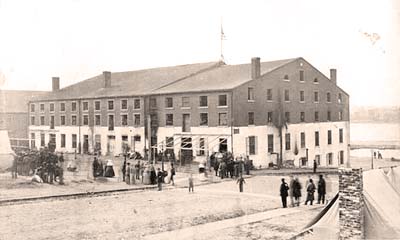
Libby Prison in Richmond. (Photo courtesy of richmondthenandnow.com)
Before the end of the war, another exciting event happened not far from Enon
Hall. Confederate Captain Thaddeus FItzhugh was ordered to capture a Union
supply boat in order to feed Lee's starving troops. He heard word of one that
would be heading for the Rappahannock River and quickly went to hunt it down in a sailing ship with all of his men dressed in civillian clothes. Fitzhugh found the steamer, the Harriet de Ford near Arundel County, Maryland. Fitzhugh asked the captain of the Harriet if he could give them passage. The captain agreed and Fitzhugh's men got on board. After they had departed and begun to make their way into the Bay, Fitzhugh positioned his men on the ship and readied to try and take her by force. The men demanded the surrender of the ship and steamed south. Union gunboats got word of the capture and began to follow the Harriet. Fitzhugh headed straight for Indian Creek in Lancaster County rather than his planned landing site, Dividing Creek. It was a smart move. The union gunboats could not get to him because the creek was too shallow. Fitzhugh steamed up Dymer Creek and unloaded all of his "liberated" goods at a safe location. The Union fleet, having discovered that Fitzhugh had relocated himself, proceeded down Dymer creek and began shelling both banks. Two houses on Dymer Creek were burned to the ground in the shelling. Little did the Union officers know, Fitzhugh had burned the Harriet and moved his goods.
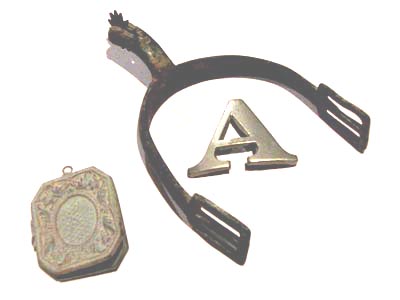
Left to right: A 19th century locket, a Horstmann spur, and a company letter
Now, 142 years after the Civil War ended, we still find traces of it here and there. Whether it is local legends like the skirmish at Pop Castle or the Enon Hall raid or artifacts, the Civil War is very much a part of local history. In 2001, a farmer in Kilmarnock plowed a live artillery shell from his field that was fired by the gunboats in persuit of the Harriet de Ford. Over the years that we have been here at Enon Hall, we have found several artifacts that could possibly have been from the raid when the blue pig was stolen. There is a Union spur, a painted tin locket, and a pewter letter A that could be Union company insignia. We had no ancestors in the Union army, so it is strange to find objects like that here. We always hear more and more little tidbits about the War and the brave people who lived through it. I always get more interested in it every time the war comes up. The way I see it, the Civil War is part of our past that is not to be forgotten or overlooked and I am glad that I could share some stories about what it was like at Enon Hall during that time. -- William
Sources:
Soldiers at the Doorstep: Civil War Lore
by Larry S. Chowning
p. 54-56
Lancaster County: Where the River Meets the Bay
by Carolyn H. Jett
p.184-210
The Stronghold
by Miriam Haynie
p.181-183
Urbanna: A Port Town in Virginia: 1680-1980
by Ryland, Simmons, Chowning, Gray, and Vaughn
p.49-50
|






